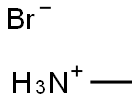Methylammonium bromide (MABr) is a precursor for the synthesis of organic-inorganic hybrid perovskites for use in FETs, LEDs and PVs. It is a precursor of MAPbBr3 perovskites. Having a band gap of 2.3 eV (HOMO 5.68 eV, LUMO 3.38 eV) [1], MAPbBr3 perovskites have been used to tune the band gap of mixed MAPbX3 (where X is the halide I, Br and/or Cl mixtures). For this reason, bromide MAPbBr3 perovskites can be utilised as light absorbers for high-energy photons, and can serve as the front cell in tandem cells. This perovskite can provide a higher open-circuit voltage in perovskite solar cells than the iodide analogue. High-efficiency solar cells, with a VOC of up to 1.40 V, a fill factor (FF) of 79%, and a PCE of 6.7% have been reported for pure MAPbBr3 perovskite solar cells. It has also been demonstrated that MAPbBr3 nanoplatelets can be employed in light-emitting diodes, exhibiting bright photoluminescence (PL) at 529 nm, with a narrow spectral band and a quantum yield up to 85%.






